Minnesota boasts a rich diversity of natural beauty, and nothing says that more clearly than its trees. To be precise, the state is home to 53 native tree species! From the towering pines of the north to the vibrant maples that give us those stunning fall colors, each tree contributes to the unique landscape of Minnesota.
In this article, we’ll discuss some of the most iconic trees that are native to Minnesota, making it easy for anyone to appreciate these living landmarks. So, if you’re interested in the outdoors or just a fan of natural beauty, this article is for you. Let’s dive in and get to know these gorgeous wonders!
What Trees Are Native to Minnesota?

There are many different types of trees native to Minnesota.
©Dan Thornberg/Shutterstock.com
Around a third of Minnesota’s land is covered in forests, making trees an essential part of the state’s landscape. Of all the numerous trees that dot the Minnesota landscape, the quaking aspen takes the title for being the most widespread tree in the state, especially dominant in the north but also found all over. Plus, this tree is the most common Populus tree found in all of North America.
Furthermore, spruce trees, both black and white, along with firs, are not just majestic to look at. They are also vital for the wood industry in the northern parts of the state. More than that, they make great natural barriers against the wind. If you’re looking for smaller trees, you will find plenty of cedars, either in white or red varieties. With their scaled needles, cedars offer both shelter and food for local wildlife.
An important tree of note, the red pine, also known as the Norway pine, has had the honor of being the state tree since 1953.
But it’s worth noting that over the past two decades, Minnesota has seen a significant loss in its tree cover — about a 9.1% reduction since 2000. This adds a layer of urgency to appreciate and protect the state’s natural wooded treasures.
So, without further ado, let’s go over and get to know 10 of the most iconic trees that grow in Minnesota.
1. American Elm (Ulmus americana)

An iconic tree native to Minnesota, the American elm can grow up to 80 feet tall.
©iStock.com/marekuliasz
The American elm is a robust, quickly growing tree that thrives across Minnesota, especially in the fertile lands in the southern part of the state. Known for its attractive and well-proportioned shape, this tree has a broad canopy that can provide ample shade.
Its leaves are sturdy and dark green, transforming into shades of yellow as the fall months set in. While you might not notice its discreet red-green flowers that bloom in the spring, they’re a part of its charm.
This tree has been a popular choice for lining streets and adorning lawns due to its imposing stature. However, it’s essential to note that many of these elms have fallen victim to Dutch Elm disease, making them less ideal for new plantings in recent times.
With a potential height of 60 to 80 feet and a width of 40 to 70 feet, this tree is quite a sight when fully grown.
If you’re considering planting one, keep in mind that it loves sunny spots and thrives in a variety of soil types, from moist to dry. It’s even resistant to drought, making it a relatively low-maintenance option if you have the space for it.
2. Eastern Hemlock (Tsuga canadensis)
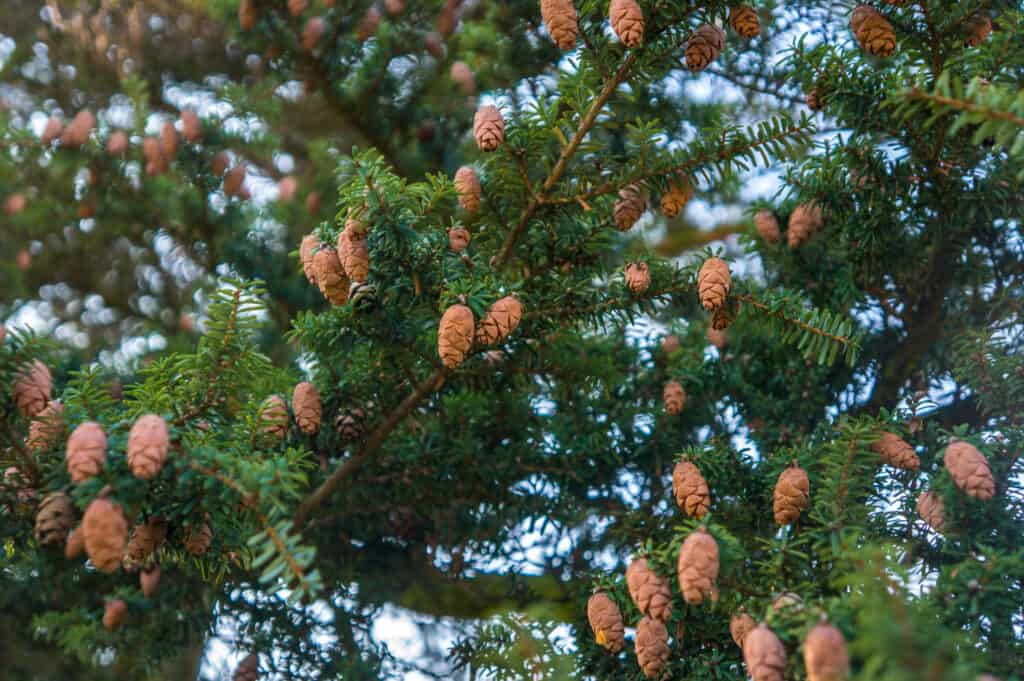
A rare yet native tree in Minnesota, the eastern hemlock can live up to 1000 years!
©iStock.com/Sara Lissaker
The eastern hemlock is a rare gem in Minnesota’s forests, and it has been facing challenges even before the days of unchecked logging altered the state’s woodland makeup. This tree is primarily found in Carlton County, near Lake Superior, with a few isolated instances in Aitkin and St. Louis counties.
This evergreen has a sturdy, vertical trunk and a broad, pyramid-like shape, covered in dense sprigs of rich green needles. These needles have a distinct two-white-stripe pattern underneath. With its long, drooping branches and tiny, hanging brown cones, the tree has a gentle elegance. Older trees often feature deeply grooved, grayish-purple bark. Interestingly, the eastern hemlock can live for many centuries, more than 800 years, with some closing in on close to 1000 years!
Growing at a moderate pace, the eastern hemlock adds about one to two feet to its height each year. It serves as a lovely shade tree and offers prime nesting spots for various bird species. When it comes to size, it can reach between 40 to 70 feet in height and spread out 25 to 35 feet.
Eastern hemlock thrives in partially shaded to sunny spots and prefers nutrient-rich, acidic, and well-draining soil. It’s also sensitive to harsh winds and can’t handle drought well, so keep that in mind when choosing its location.
3. American Basswood (Tilia americana)

A favorite native tree in Minnesota, the American basswood boasts pale yellow flowers in the summer.
©Alina Vaska/Shutterstock.com
The American basswood is a common sight in many of Minnesota’s lush forests, especially in the central and southeastern parts of the state. This tree is a key component of the area’s Maple-Basswood woodlands.
This tree is also a favorite for city landscaping in Minnesota. Its soft, fine-grained wood is highly valued for carving and can also be used to make furniture and paper products.
With large, dark green leaves that can grow up to six inches long, the American basswood tree provides a generous canopy. The leaves turn a subtle yellow-green come autumn. In the early part of the summer, the tree blooms with pale yellow flowers that have a sweet fragrance and are a favorite among bees. These flowers are a significant source of rich, robust honey.
After flowering, the tree produces tough little nuts that mature toward the end of summer. When young, the tree’s bark has a smooth, shiny texture, ranging from gray to brown. As the tree ages, the bark becomes more textured, developing ridges and furrows. This makes it a visually appealing tree for both shade and lining streets.
The American basswood can grow to heights between 60 and 80 feet tall and can spread out 30 to 50 feet wide. When it comes to planting, it’s not very picky: it thrives in full sun to partial shade and prefers soil that’s moderately moist but well-draining.
4. American Mountain Ash (Sorbus americana)
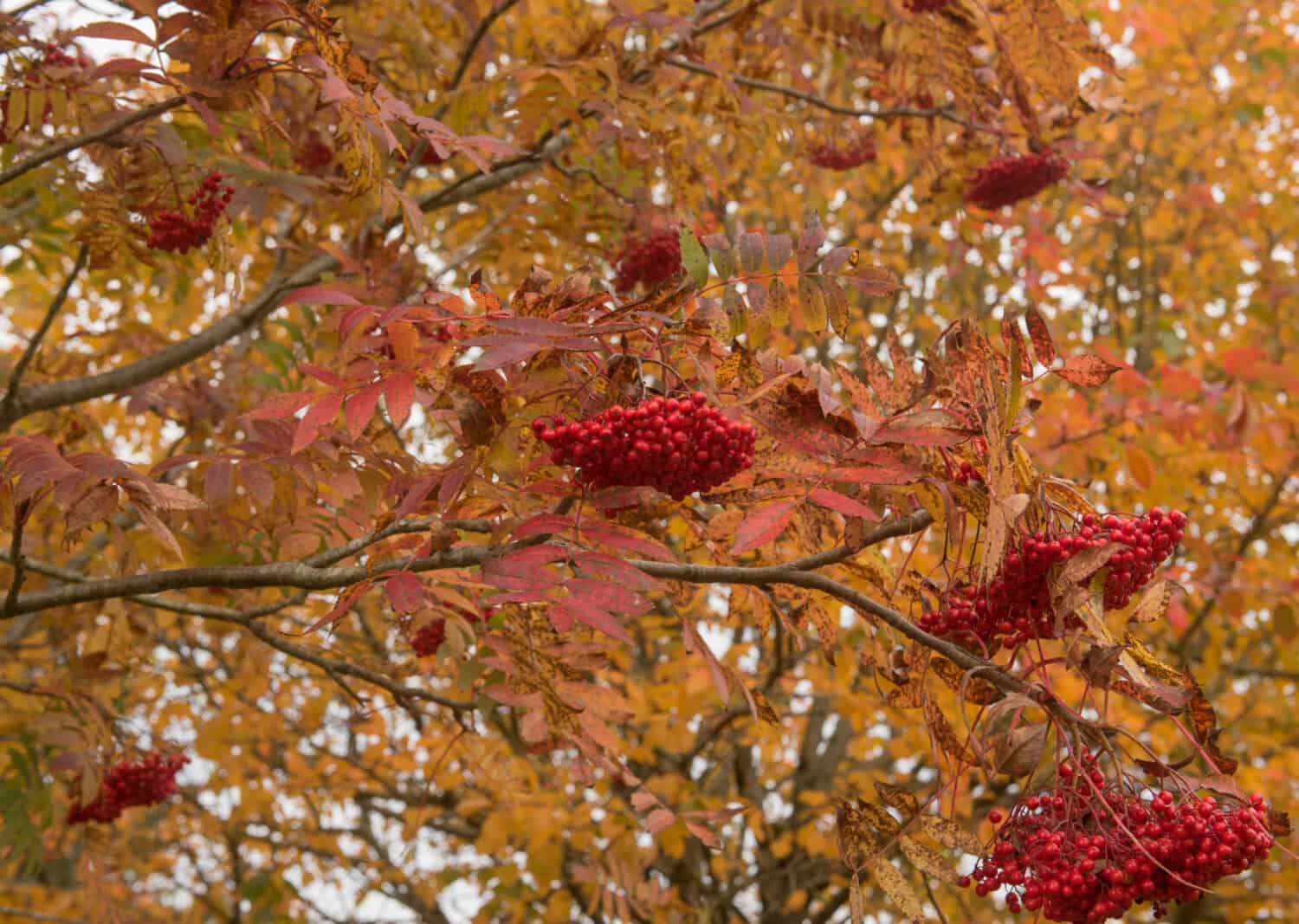
Boasting orange-red berries in the summer, the American mountain ash is beautiful year-round.
©Peter Turner Photography/Shutterstock.com
The American mountain ash is a versatile tree that you’ll find in various parts of northern Minnesota. It’s especially abundant near swamp edges in the northeastern part of the state.
This tree may be small, but it is striking, with a slender trunk and branches that spread out to create a rounded outline. Its dark green leaves alternate on a stem, about 6 to 10 inches long. In the fall, these leaves, each around 2 to 4 inches long, change to shades of orange, purple, and red. This color change certainly adds a dramatic touch to the landscape.
Although the American mountain ash starts off with smooth gray bark, as with most trees, it becomes scaly as it ages.
During late spring, the tree blooms with small white flowers arranged in flat clusters. These flowers soon give way to eye-catching clusters of vibrant orange-red berries by late summer. These berries can be used both fresh and dried. With its ever-changing appearance, the American mountain ash offers something to admire in almost every season.
In terms of size, it’s a modest tree, growing between 10 to 30 feet in both height and width. It’s happiest in full sun and thrives in soil that’s acidic, moist, and rich in organic matter.
5. Black Willow (Salix nigra)

Native to Minnesota, black willow trees are generally found in damp or soggy areas.
©Sue Burton Photography/Shutterstock.com
In Minnesota, you’ll find more than 20 different willow species, but the black willow is particularly widespread. It’s usually found in damp or soggy areas that frequently flood, like the edges of lakes and rivers. This adaptable plant can either be a large bush or grow into a substantial tree.
This type of willow is a rapid grower and typically develops multiple trunks that lead up to an open and somewhat rounded treetop, full of strong branches. During the warmer months, the tree showcases slender, finely-edged leaves that are a shade of medium to dark green and about 2 to 6 inches long. As the fall approaches, these leaves shift to a yellowish-green hue before they fall off, displaying the tree’s interesting skeletal structure.
The black willow is unique in that it has either male or female flowers, but not both on the same tree. These flowers manifest as soft, yellow-green tassels or catkins, measuring around 2 inches. By late spring, these give way to reddish-brown seed pods that are carried away by the wind.
Though this tree doesn’t have a long lifespan, the black willow stands as North America’s largest and only commercially valuable willow species. It’s an ideal tree to plant near bodies of water, not just for its beauty but also because its roots help hold the soil together. This makes it extremely useful for combating soil erosion along riverbanks and lakesides.
This tree can reach heights and widths ranging from 30 to 60 feet and does best in locations with plenty of sunlight or partial shade, but it requires soil that stays wet or moist.
6. Black Oak (Quercus velutina)
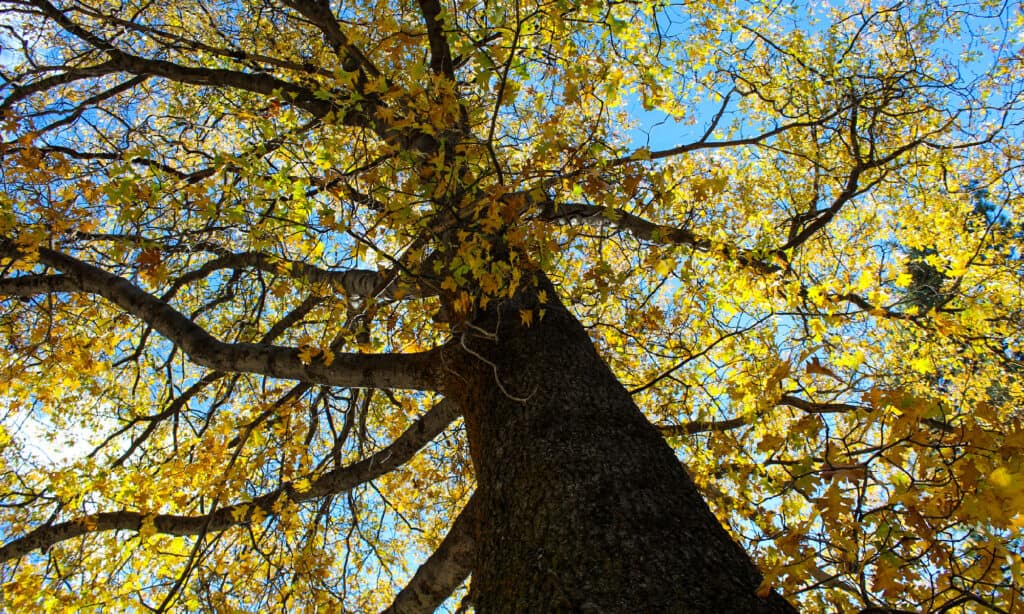
A medium to large tree, the black oak is generally found in the southeastern side of Minnesota.
©iStock.com/Jared Quentin
The black oak is primarily found in the southeastern edge of Minnesota and is notably resilient to dry conditions. It often grows on hills and ridges where many other trees struggle to survive due to lack of water.
This tree can be medium to large in size, with a crown that’s somewhat unevenly shaped. It has sizeable leaves that can be up to 10 inches long and have 7 to 9 deep cuts or “lobes.” These leaves are shiny and dark green on the top and lighter on the bottom, and they turn into vivid yellows, oranges, or browns during the fall months. Small, yellow-green flower clusters, known as catkins, show up in the spring, often just as the leaves start to grow.
While the black oak isn’t commonly planted for decorative purposes, its striking fall foliage does add significant visual appeal to any oak forest. It’s also a good choice for providing shade in large open spaces.
As for its growth, the tree can reach dimensions of 40 to 60 feet in both height and width. It thrives best in sunny locations with soil that ranges from dry to moderately moist and is well-drained. Although it prefers fertile, moist soil, it’s often seen growing in less ideal conditions like dry, sandy, or heavy clay areas. The black oak’s lifespan is generally less than 200 years.
7. Red Oak (Quercus rubra)

Native to Minnesota, the red oak tree is incredibly expansive and boasts large leaves.
©Pawel Horazy/Shutterstock.com
The red oak is abundant across Minnesota, but it particularly thrives in the southern, central, and southeastern parts of the state.
This quick-growing deciduous tree is known for its expansive, somewhat rounded canopy. Its large, glossy leaves have between seven and 11 serrated edges and change from a dark green color to vibrant shades of red or russet in the fall. When spring arrives, small yellow-green flower clusters, also known as catkins, emerge alongside new leaves.
The new spring leaves have an eye-catching dusty bronze-red hue, making the tree as visually appealing as those that bloom in the spring. Adding to its unique appearance, the upper trunk and branches feature pale gray lines running lengthwise, giving them a look reminiscent of ski tracks.
A majestic and versatile tree, the red oak is well-suited for large spaces and can even flourish in urban settings. It also serves as New Jersey‘s state tree and is a widespread emblem of resilience and fortitude in American lore.
In terms of size, the red oak can reach a height and width ranging from 50 to 70 feet. It does best in sunny to partly shaded locations and thrives in well-drained soil that is acidic and rich, whether it’s sandy or loamy.
8. Black Cherry (Prunus serotina)

Found in the central and southeastern parts of Minnesota, the black cherry has tiny round berries.
©iStock.com/TeleMakro Fotografie (Ina Hensel)
The black cherry is the largest member of the Prunus family in Minnesota and is commonly found in the central and southeastern parts of the state’s woodlands.
In its early years, this deciduous tree has a pyramid-like shape that eventually matures into an oval form with wide, sweeping branches. Its drooping limbs are covered in glossy, green leaves that are about 5 inches long and have finely jagged edges. These leaves turn into vibrant shades of yellow and red come fall. Between late spring and early summer, the tree bursts into aromatic white flowers that hang in clusters and are roughly 6 inches long. These blooms appear just as the new leaves do.
These flowers eventually develop into small, round berries that start off red and turn dark purple-black by late summer. While not particularly tasty to humans, these berries are a magnet for birds and wildlife. However, with that said, people do collect these berries for making jams and jellies.
In terms of growth, this tree can reach heights between 50 and 80 feet and span widths from 30 to 60 feet. It also has a tendency to sprout a lot of stray seedlings. For optimal health, it needs a sunny or partly shaded spot with soil that is moist yet well-drained.
9. Red Pine (Pinus resinosa)
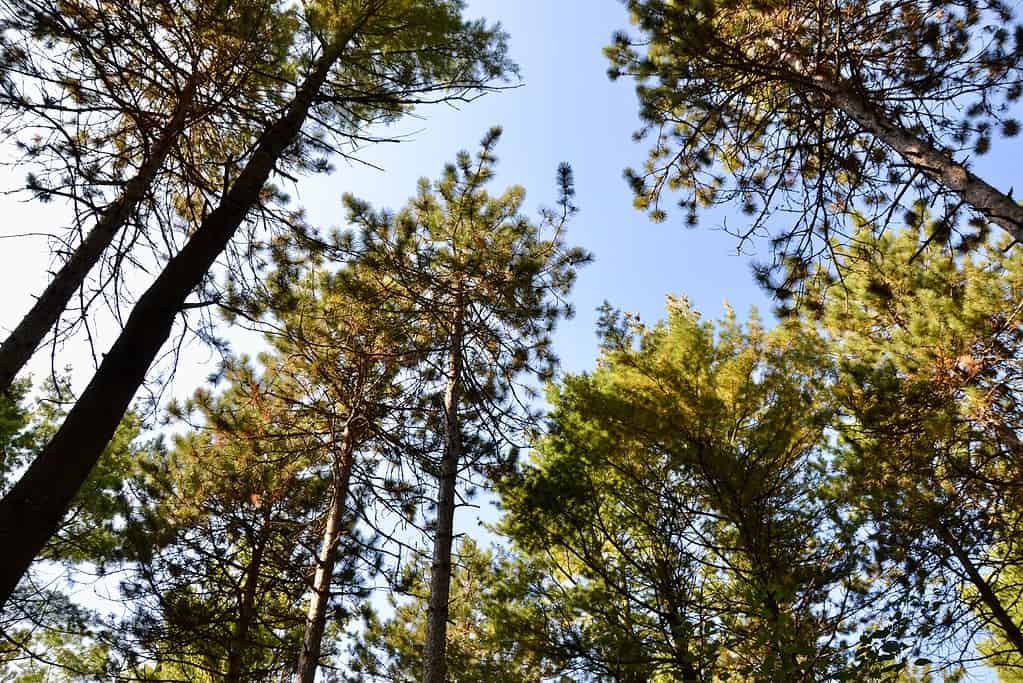
The state tree of Minnesota is the red pine.
©Chris Dale/Shutterstock.com
The red pine, which holds the honor of being Minnesota’s state tree since 1953, has an impressive lifespan that can stretch up to 400 years. You’ll find this evergreen growing in sandy plains and gentle hills near lakes and swamps in northeastern Minnesota.
This medium-sized evergreen has a cone-shaped look with a straight main stem and branches that reach both out and up, culminating in a somewhat rounded top. Its needles are green, anywhere from yellowish to dark shades, and they come in pairs that are about 6 inches long. These needles are pretty fragile and snap easily if you bend them.
The tree produces seed cones that are about 2.5 inches long and have a light reddish-brown color. These cones take two years to fully mature and open up. The tree’s bark has a cinnamon-brown hue and features a textured pattern that looks like irregular rectangular scales.
In terms of size, the red pine can get quite tall, reaching between 50 and 100 feet in height, but it can grow up to 150 feet in some cases. Its width spans about 20 to 25 feet. It loves a sunny spot and does best in soil that is well-drained and moderately moist, although it can also handle drier conditions pretty well.
10. Honey Locust (Gleditsia triacanthos)
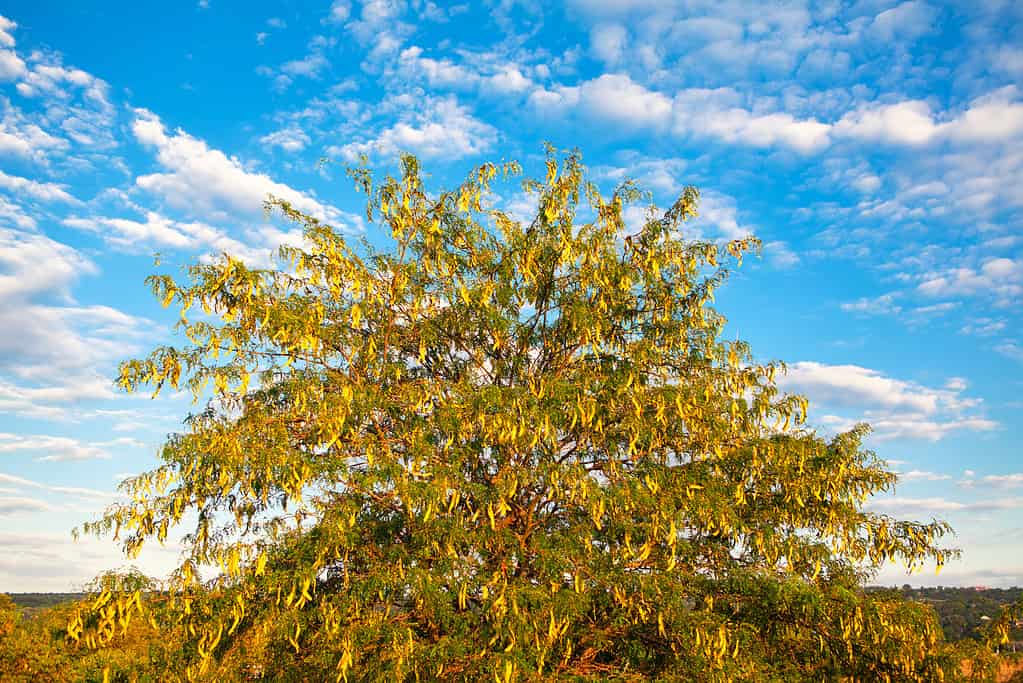
Boasting a gorgeous yellow color in the fall, the locust tree is found in southern Minnesota.
©RussieseO/ via Getty Images
The honey locust tree is commonly seen in southern Minnesota, especially near the Root River Valley and along the Mississippi lowlands. While it does grow in forests, you’re more likely to spot it in open or disturbed areas next to roads and fields.
This deciduous tree grows quickly and can live for a long time. It has a wide and rounded top, and its leaves are bright green, feather-like, and glossy. These leaves turn a vivid yellow hue in the fall. What’s more, the tree doesn’t block much sunlight, making it easier to grow other plants beneath it. It has small, barely noticeable flowers that bloom from late spring into early summer.
Be cautious, though. This tree comes with thorns growing out of the branches that are about 3 inches long and can be quite dangerous. Therefore, it’s not the best choice for backyards or playgrounds.
The honey locust tree can grow between 60 and 80 feet tall. Just be mindful that it can spread rapidly and sometimes become problematic in grazing lands. This tree thrives in sunny areas and likes soil that is both rich in organic matter and well-drained.
Summary of the Most Iconic Trees Native to Minnesota
| Number | Tree | Botanical Name |
|---|---|---|
| 1 | American Elm | Ulmus americana |
| 2 | Eastern Hemlock | Tsuga canadensis |
| 3 | American Basswood | Tilia americana |
| 4 | American Mountain Ash | Sorbus americana |
| 5 | Black Willow | Salix nigra |
| 6 | Black Oak | Quercus velutina |
| 7 | Red Oak | Quercus rubra |
| 8 | Black Cherry | Prunus serotina |
| 9 | Red Pine | Pinus resinosa |
| 10 | Honey Locust | Gleditsia triacanthos |
The photo featured at the top of this post is © iStock.com/marekuliasz
Thank you for reading! Have some feedback for us? Contact the AZ Animals editorial team.







